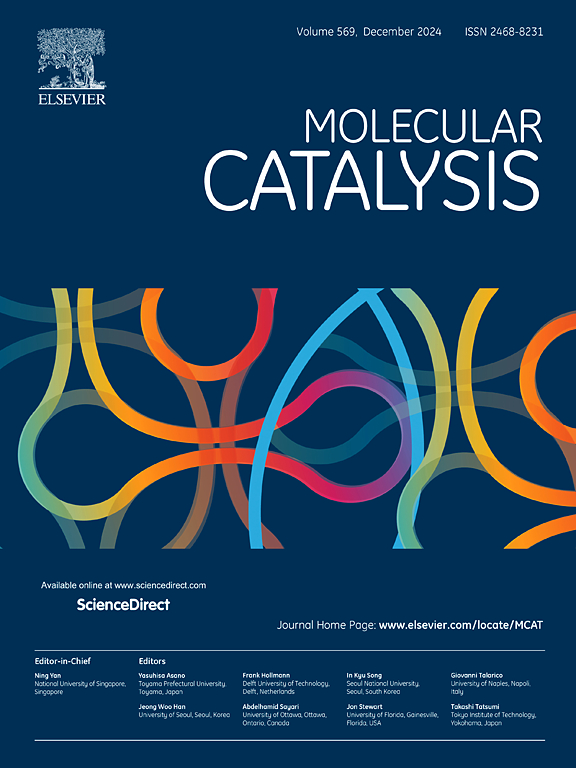Band gap effect of TiO2 on supported Ru single-atom catalysts for CO2 methanation by DFT calculations
IF 4.9
2区 化学
Q2 CHEMISTRY, PHYSICAL
引用次数: 0
Abstract
The influence of TiO2 band gap on structure and reactivity of the supported single ruthenium (Ru1) atom was studied by density functional theory calculations, utilizing Ru1/2L-TiO2 and Ru1/3L-TiO2 as model catalysts for CO2 methanation. The supports have band gaps of 2.39 eV and 1.48 eV, respectively. The band gap plays a significant role in electronic metal-support interactions (EMSIs) and the position of the d-band center of the Ru1 on the TiO2. The Ru1/3L-TiO2, the Ru1 catalyst supported on the 3L-TiO2 with a narrower band gap, shows enhanced EMSIs and a d-band center that is positioned farther from Fermi level, leading to lower charge density on the Ru1 and weaker adsorption of H2, CO2, and CO compared to the Ru1/2L-TiO2. CO2 methanation followed CO pathway, with the hydrogenation of CO* to HCO* identified as the rate-determining step on the Ru1/nL-TiO2. The Ru1 catalyst supported on TiO2 with a narrower band gap is more favorable kinetically and thermodynamically for CO2 methanation, despite the band gap not altering the reaction pathway. Enhanced hydrogen mobility and a pronounced promotional effect of hydrogen on CO adsorption, due to the narrower band gap support, are key factors facilitating the easier hydrogenation of CO* on the Ru1/3L-TiO2.
通过 DFT 计算确定 TiO2 对支撑 Ru 单原子催化剂 CO2 甲烷化的带隙效应
利用 Ru1/2L-TiO2 和 Ru1/3L-TiO2 作为二氧化碳甲烷化的模型催化剂,通过密度泛函理论计算研究了 TiO2 带隙对支撑单钌 (Ru1) 原子的结构和反应活性的影响。这两种载体的带隙分别为 2.39 eV 和 1.48 eV。带隙在电子金属-载体相互作用(EMSIs)和 TiO2 上 Ru1 的 d 带中心位置中起着重要作用。与 Ru1/2L-TiO2 相比,Ru1/3L-TiO2(Ru1 支撑在带隙较窄的 3L-TiO2 上的 Ru1 催化剂)显示出更强的电子金属-支撑相互作用(EMSIs)和更远离费米级的 d 带中心位置,导致 Ru1 上的电荷密度更低,对 H2、CO2 和 CO 的吸附更弱。CO2 甲烷化遵循 CO 路径,在 Ru1/nL-TiO2 上,CO* 加氢为 HCO* 是决定速率的步骤。尽管带隙不会改变反应途径,但在带隙较窄的 TiO2 上支撑的 Ru1 催化剂在动力学和热力学上更有利于 CO2 甲烷化。较窄的带隙支撑增强了氢的流动性,氢对 CO 的吸附具有明显的促进作用,这些都是 Ru1/3L-TiO2 上 CO* 更容易加氢的关键因素。
本文章由计算机程序翻译,如有差异,请以英文原文为准。
求助全文
约1分钟内获得全文
求助全文
来源期刊

Molecular Catalysis
Chemical Engineering-Process Chemistry and Technology
CiteScore
6.90
自引率
10.90%
发文量
700
审稿时长
40 days
期刊介绍:
Molecular Catalysis publishes full papers that are original, rigorous, and scholarly contributions examining the molecular and atomic aspects of catalytic activation and reaction mechanisms. The fields covered are:
Heterogeneous catalysis including immobilized molecular catalysts
Homogeneous catalysis including organocatalysis, organometallic catalysis and biocatalysis
Photo- and electrochemistry
Theoretical aspects of catalysis analyzed by computational methods
 求助内容:
求助内容: 应助结果提醒方式:
应助结果提醒方式:


